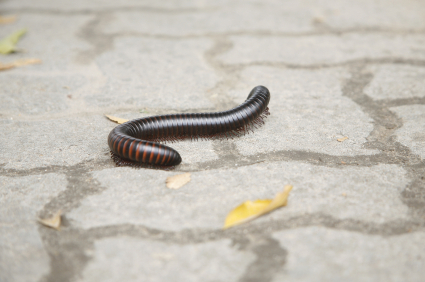Identification
There are over 8,000 species of centipedes throughout the world and 1,000 different species in the United States. Approximately 500 of these species are found throughout the east coast.
Centipedes and millipedes are not insects because they have more than six legs, but they are closely related invertebrates. These creatures are considered arthropods similar to spiders, ticks and even lobsters! The phylum Arthropoda simply means “jointed legs”. When outdoors, these invertebrates are harmless creatures, but they are usually pests when they decide to invade our homes and buildings. Both of these groups of invertebrates have long, segmented bodies with centipedes have one pair of legs on each segment while millipedes have two pair of legs per segment.
Millipedes
As a household pest, millipedes are more of an annoyance or nuisance, rather than an indoor-breeding pest that cause destruction. Millipedes normally are found outdoors. As stated above, this occasional invader has two pair of legs per body segment (as compared to the centipede, which has one pair per segment,) except for the first three segments, which have one pair of legs per segment. Millipedes are not poisonous, but many species have special glands capable of producing mild acids, which may produce allergenic reactions in sensitive individuals. Millipedes are primarily scavengers, they are found in damp places eating organic material.
Centipedes
Centipedes usually are found in damp, dark places, such as under stones, leaf mulch, or logs. Indoors, centipedes may be found in damp areas of basements, crawlspaces, closets, bathrooms, or anywhere in the home where other insects are found. During the day they hide in dark cracks and crevices, coming out at night to search for insects to eat. Centipedes are predators and generally play a beneficial role in the garden; they are adapted to be swift hunters. These creatures eat flies, cockroaches, and other small household pests. The presence of centipedes may be an indication of other insect problems. Because Centipedes are hunters they have poison glands and can bite, pose an occasional threat to humans.
How, When and Why They Become a Nuisance
They are not known to carry any diseases. Centipedes are beneficial, as they eat so many insects. Millipedes can damage gardens. Some cause painful bites. Typically Millipedes and Centipedes cause a fearful reaction or just creep people out. Centipedes do have poison glands and can bite humans causing discomfort.
Atlanta, Georgia Millipede Removal & Centipede Pest Control
Urban Wildlife Control provides cockroach extermination services for home and businesses in Atlanta and Georgia. We utilize a combination of removal, exclusion and insecticide application methods to promptly eradicate roach populations, and our ongoing monitoring and maintenance service will provide long-term protection.
Millipedes do no damage indoors and pose no real health risks. Those that come inside homes can get rid of by picking up and flushing down the toilet or putting outside. Sealing cracks and other openings, also known as exclusion, from outside helps prevent them from entering.
Eliminating moist hiding places around the home will kill or discourage millipedes. Outdoors, this includes removing rotting wood and decaying grass and leaves from around the house’s foundation or roof. This also eliminates millipede food sources. If there is unnecessary dampness in crawl spaces or basements proper measures should be taken to dry out these areas.



